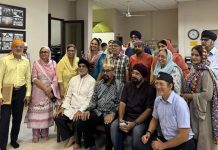Title: Sakhi Sikh Rehat Maryada Ji Ki
Author: Gurucharanjit Singh Lamba
Publisher: Sant Sipahi LLC (USA)
Price: Indian rupees 550 and US Dollars 15.
 By Bhai Harbans Lal | BOOK REVIEW |
By Bhai Harbans Lal | BOOK REVIEW |
The book under review, Sakhi Sikh Rehat Maryada Ji Ki, contains a narration, an extensive commentary, and the day-by-day accounts of how the present version of the Sikh Maryada was brought into existence.
There are several previous book narrations of rehatname but they are each derived and written by a single author. Also, they are only narratives. In contrast, Gurcharanjit Singh made a radical departure towards stating the real advances of the processes used in constructing the current Rehat Nama. Further, in contrast to others, the Shromni Gurdwara Parbandhak Committee (SGPC) Rehat Maryada is not tainted as rehat of the Khalsa, but it is the Rehat for the whole Sikh nation that included also others than Khalsa like sehajdharis.
The writer, Sardar Gurcharanjit Singh Lamba is an attorney by training but has been an activist on Sikh issues particularly related to the evolution of the Sikh message through the glorious history of the Sikhs.
I met Sardar Lamba during our youth days in India when we were both activists in the All-India Sikh Students Federation (AISSF). I found him very committed to the Sikh causes and particularly the functioning of the SGPC and Akal Takhat.
To know why the Sikh leadership felt the necessity of formulating the Rehat Maryada, you must go back to the days when its necessity seems to have been felt. In 1849 British annexed the Northern Indian subcontinent that the Sikhs considered as their kingdom and their homeland. This annexation became a visible embarrassment among Sikhs, and they tended to easily succumb to religiosity available elsewhere for their identity. Hindu radicalism visibly began to take advantage of the situation by engaging in exploitation of the Sikhs’ recession. Hindu fanatics found the opportunity to suck Sikhs into their religious practices.
For illustration, in 1897, in a large public meeting at Lahore, the Sanatanist Hindus passed a resolution that the Sikhs were a part of the Hindu community. The Bharat Dharm Mahamandal took notice of this issue and passed a resolution in a meeting at Delhi, asserting that the ten Gurus of the Sikhs from Guru Nanak to Guru Gobind Singh were revivalists of Hindu Dharma. Hindu activists recruited Baba Khem Singh Bedi, a descendant of Guru Nanak, and Bawa Sumer Singh (Bhalla), a descendant of Guru Amar Das, to subscribe to the view that Sikhs were Hindus as their Gurus were revivalists of Hinduism.
Further, Hindu statutes including a Shivling and others began to reappear in the circumambulatory passage (parikrama) of the Golden Temple. Similarly, a painting showing Guru Gobind Singh standing with folded hands before the Hindu Goddess asking for Amrit, an elixir of life, began to appear in the historical Sikh Gurudwaras.
The Sikh leadership of the time reacted. They felt a necessity to formulate the Sikh religiosity, often contra to the Hindu religiosity, as a wall between the Sikhs and those who were not. In the book under review, Sardar Lamba details how the Sikh leadership took almost a century to come up with the document now known to be the Sikh Rehat Maryada as authored by SGPC. Mind you this is different than re-writing of the Sikh history. That task is left to the scholars appointed by the Sikh institution of higher education. In contrast, the Sikh Rehat Maryada was formulated by the Sikh clergy with the help of the Sikh academicians.
Sardar Lamba starts from January October 1910 when Chief Khalsa Diwan asked a special committee to formulate a Sikh Rehat. In March 1915, Chief Khalsa Diwan published a description of the Sikh religiosity. However, the formulation of the current Rehat Maryada, then labeled Roho Reeti, began with a meeting on March 13-15, 1927, and ended with the report to SGPC on February 3, 1945. SGPC then accepted the report in its general body meeting and gave it the title of Sikh Rehat Maryada. I take pride in becoming a part of its history in that, when the Maryada was first printed as hard copies at Guru Ram Das Printing Press, in March 1945, late Principal Satbir Singh and I were asked to read and correct the final proof to catch and correct the type-setting errors. It was the occasion when AISSF was meeting in Amritsar to formulate its bylaws at its annual general body meeting.
Sardar Lamba narrates all Rehat Maryada meetings concerning their attendees and the proceedings. One may notice that all attendees were required to be practicing rehat of the khande-di-pahul as was practiced at that time. Only one sehajdhari Sikh attended that too only once. Representatives from the USA and Burma were among those who attended the meetings. All suggestions and amendments were recorded. There was the rule of 90% agreement before any amendment was accepted for incorporation.
The book gives 118 keywords at the end to search in the book of 465 pages. In the second part of the book, the author narrates the religious procedures to follow as they are derived from the language used in the final document.
The author religiously adhered to the hard evidence on how, who and when? He does not miss any detail including the evolution of the color of the Sikh flag. I feel disturbed when I notice the tendency of using the RSS ‘s bhagwa or saffron color of the flag today being hurled on some gurdwaras in the west or in the east. Author religiously observed to the hard evidence on how and when the saffron color of the flags hoisting on our gurdwaras replacing the Basanti color prescribed in the Rehat. While discussing the final text, the author emphasizes that a Sikh in Rehat Maryada was defined by one’s implicit and explicit faith in the teachings of the gurus as imbibed in SGGS. That was the only criterion not to be ever compromised.
The book is recommended for not only general readings but for research scholars and academicians; all those interested in the implicit and explicit religiosity of a Sikh’s religious life will benefit. It will also serve as a resource for those interested in comparative religion studies, and those interested in the colonial influences on the practices of the Sikh religion. Graduate students and established scholars will equally benefit.
 Harbans Lal, Ph.D.; D.Litt (Hons) is the Professor Emeritus & Chairman at the Dept of Pharmacology & Neurosciences, University of North Texas Health Science Center. He is also the Professor Emeritus at the Amritsar-based Guru Nanak Dev University as well as President of the Academy of Guru Granth Studies. He can be reached at Japji2050@gmail.com. Link to the original article.
Harbans Lal, Ph.D.; D.Litt (Hons) is the Professor Emeritus & Chairman at the Dept of Pharmacology & Neurosciences, University of North Texas Health Science Center. He is also the Professor Emeritus at the Amritsar-based Guru Nanak Dev University as well as President of the Academy of Guru Granth Studies. He can be reached at Japji2050@gmail.com. Link to the original article.
* This is the opinion of the writer, organisation or publication and does not necessarily represent the views of Asia Samachar.
RELATED STORY:
(Asia Samachar, 31 May 2020)
ASIA SAMACHAR is an online newspaper for Sikhs / Punjabis in Southeast Asia and beyond. Facebook | WhatsApp +6017-335-1399 | Email: editor@asiasamachar.com | Twitter | Instagram | Obituary announcements, click here |



































Sikhs were recognized and accepted as 3rd political entity along with Hindus and Muslims by the British rulers in their official document Communal Award 1932 . They were offered political rights before 1947 but their leader Akali Tara Singh, real name Nank Chand malhotra tricked them into Hindu India at the instance of Hindu Congress leaders . Since then they are considered part of Hindus , legally . Even Tara Singh used to admit orally and in writing that the Sikhs are a branch of Hindu tree . In 1944 he as a President of SGPC, Amritsar had got amended Gurdwara Act 1925 and added the voting right of so-called SEHAJDHARIS . This G S Lamba is following the line of Tara Singh but not accepted by major part of the Sikhs but he has support of Hindu lobby among media , therefore, his writings are under Sikh scanner !